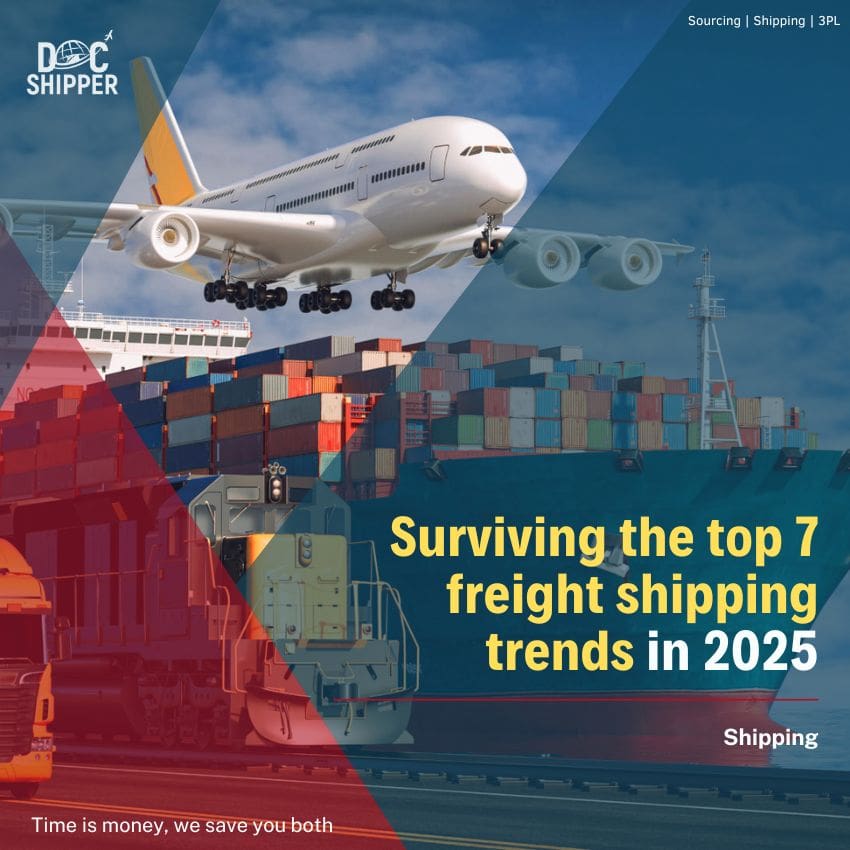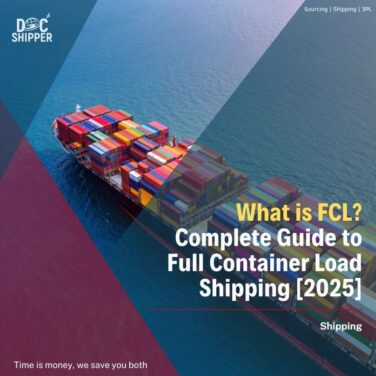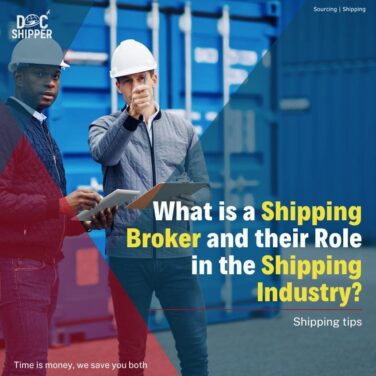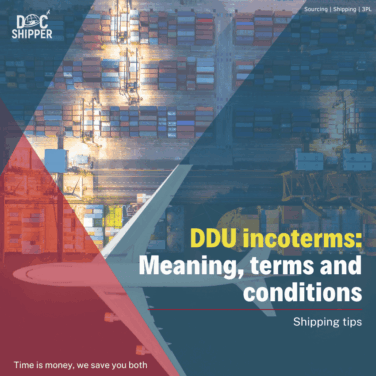The last two years have been marked by major challenges for freight transport: inflation, port congestion, driver shortages, capacity problems and geopolitical tensions affecting tariffs. These challenges look set to continue into 2025. Since many of these trends are beyond your control, it’s essential to call on an experienced provider, like Siam Shipping, to manage these complex issues.
Customer expectations have evolved, with increased demands for flexibility, transparency, and environmental friendliness. What’s more, the impact of COVID-19 has brought about lasting changes in the industry, affecting the priorities of those involved.
We’ve created this guide to help you anticipate and understand these trends. Let’s explore together the seven main trends in freight transport in 2025 and how companies can adapt to them.
Trend 1: The Rise of Green Logistics Across All Transport Modes
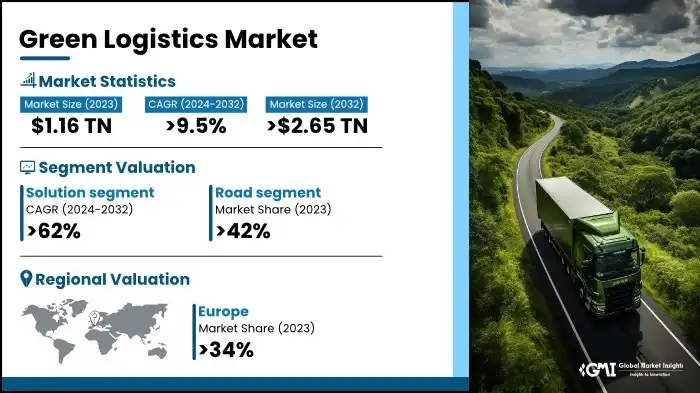
Definition
The logistics sector is undergoing an environmental transformation as regulations become stricter across all transport modes. In 2025, initiatives such as the EU’s “Fit for 55” package, the U.S. Clean Truck Plan, and the International Maritime Organization’s new emission standards are driving the shift towards greener logistics operations. This freight shipping trend affects road, sea freight, and all other freight modes, pushing companies to adopt sustainable practices. However, these changes come with challenges such as increased operational costs, longer replacement cycles for vessels and trucks, and infrastructure limitations for alternative fuels like hydrogen, electricity, and biofuels.
Current Statistics
As environmental concerns continue to rise, businesses must adapt to the shift toward greener logistics, meeting both regulatory requirements and growing customer expectations for sustainability.
- 72% of B2B buyers now prioritize logistics partners who provide transparency on environmental impact in 2025.
- 64% of B2C consumers are more likely to choose companies demonstrating a commitment to sustainability in their logistics operations.
Customer Impact
As environmental regulations tighten, customer expectations have shifted. B2B and B2C buyers now prioritize logistics providers that align with sustainability values. In 2025, businesses face pressure to demonstrate eco-responsibility through transparent metrics and green logistics. A key freight shipping trend is the demand for sustainable practices across the supply chain. Customers expect efficient service with reduced carbon footprints, requiring businesses to balance environmental impact with speed, cost-effectiveness, and reliability.
Industry Examples
Major players in logistics are increasingly adopting sustainable practices as part of their core strategies. These efforts not only align with regulatory changes but also meet the rising demand for environmental solutions.
- Maersk: The global shipping giant has committed to becoming carbon neutral by 2050 and has started deploying biofuel-powered vessels to meet new emission standards. The company’s efforts are an example of how major players in the maritime sector are adapting to the increasing demand for sustainability.
- DHL: DHL has introduced electric delivery vehicles across several European cities as part of its strategy to reduce carbon emissions. With the implementation of clean technologies, DHL is responding to both regulatory pressures and consumer demand for more sustainable logistics services.
Actionable Advice
To stay ahead of the curve, here is some advice that companies must invest in green logistics solutions that comply with evolving regulations while meeting the increasing demand for eco-responsibility among consumers.
- Invest in Clean Technologies: Companies should prioritize investments in electric, hydrogen, and biofuel-powered vehicles to comply with environmental regulations and meet consumer expectations for sustainability.
- Collaborate with Multimodal Providers: Partner with logistics providers offering flexible, multimodal solutions that integrate sustainable practices, such as bulk shipping, to reduce packaging and minimize emissions.
- Make the switch to sustainable shipping materials provides advantages for your company in addition to benefiting the environment. According to the study, 50% of customers are more likely to make an online purchase if the product’s packaging can be recycled.
Trend 2: Hyperlocalization and Micro-Fulfillment Become Essential
Definition
In response to rising ground transportation costs and ongoing driver shortages, hyperlocalization and micro-fulfillment strategies are becoming essential in the logistics industry by 2025. As long-distance freight shipments become increasingly expensive and prone to delays, businesses are shifting towards multiple smaller, automated fulfillment centers placed closer to major consumer hubs.
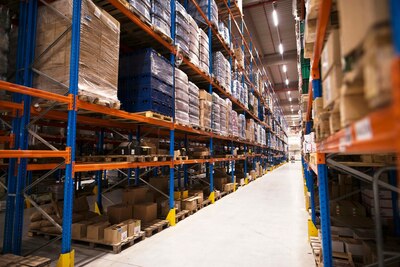
This decentralized approach allows companies to reduce shipping distances and improve the speed and reliability of deliveries.
Current Statistics
As businesses adapt to these changes, these statistics reflect the growing importance of faster and more localized delivery strategies:
- 84% of online shoppers now prioritize same-day or next-day delivery.
- 62% of businesses are adopting hyperlocalization strategies, with micro-fulfillment centers in urban areas, to meet consumer demand for faster delivery in 2024 .
- In 2025, Ground transportation costs have increased by 15% on average in the past year due to rising fuel prices and driver shortages.
Customer Impact
Customer expectations in 2025 have shifted significantly due to the need for faster, more flexible delivery options. As long-distance transportation becomes less viable, consumers now expect same-day or next-day delivery as the standard. This has heightened demand for real-time inventory visibility and order tracking, regardless of the shopping channel. Hyperlocalization is a response to these demands, ensuring that businesses can provide rapid, efficient deliveries without sacrificing reliability. As a result, companies are required to offer a seamless, omnichannel experience with real-time updates and faster fulfillment times.
Industry Examples
Big companies that strategically implement these models are better positioned to meet rising customer demands for faster, more efficient deliveries. Here are some examples:
- Walmart: Walmart has embraced micro-fulfillment by establishing small, automated fulfillment centers in major metropolitan areas. These centers enable quicker deliveries and improved inventory management, allowing the company to offer competitive same-day delivery options to customers.
- Amazon: Amazon’s investment in hyperlocalization has accelerated, with the company building smaller fulfillment hubs closer to urban centers. This has reduced delivery times and helped Amazon maintain its promise of rapid, reliable delivery across the globe.
Actionable Advice
As the demand for faster deliveries continues to rise, businesses must focus on agility and innovation in their logistics networks. These steps will help ensure your company meets growing customer expectations.
- Invest in Micro-Fulfillment Centers: Companies should consider setting up smaller, automated fulfillment centers in strategic locations closer to key customer bases to reduce transportation costs and improve delivery speed.
- Implement Real-Time Inventory Systems: Leverage advanced technology for real-time inventory visibility and order tracking to meet customer demands for transparency and faster fulfillment.
- Offer customers multiple, precise shipping options and consider flat-rate shipping to make it easier for them to choose the most efficient delivery.
Siam Shipping Alert
DocShipper Alert : Managing multiple warehouses may not always be the most effective solution for every business. Before adjusting your storage strategy, it’s essential to assess how it will impact your entire supply chain. DocShipper is here to streamline your operations with our Storage & Warehousing Services, ensuring that your logistics run smoothly. Contact our experts today to discuss the most efficient approach for your business, find the most suitable solution, and optimize your storage and warehousing processes.
Trend 3: Rates for LTL and TL continue to be influenced by inflation and labor shortages
Definition
In 2025, rates for Less Than Truck Load (LTL) and Truckload (TL) shipping continue to be significantly impacted by ongoing inflation, labor shortages, and regulatory changes. The COVID-19 pandemic’s residual effects, including a shortage of experienced truck drivers and rising fuel prices, contribute to higher shipping costs. Additionally, the retirement of experienced drivers and new environmental regulations further exacerbate these challenges. This trend creates an environment of uncertainty, with shipping companies facing pressure to manage costs.
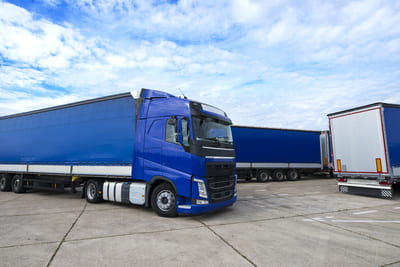
Current Statistics
- Less than Truck Load shipping rates have increased by 8-10% since pre-pandemic levels, driven by the ongoing shortage of drivers and increased operational costs.
- TL shipping rates are up by 6-9%, with fuel price fluctuations and the need for compliance with stricter environmental regulations playing a large role.
Customer Impact
As shipping costs keep rising, customer expectations have shifted towards greater transparency and flexibility. Consumers now demand clear communication about pricing changes and delays, especially in an era of unpredictable supply chains. Faster delivery times and more predictable shipping costs are top priorities. When shipping fees increase, customers expect enhanced services, such as better tracking systems and more flexible delivery options, to justify the higher costs. However, while consumers continue to love free shipping, covering these costs can place significant strain on the profits of e-shipping businesses.
Industry Examples
Many companies are adjusting their strategies in response to rising freight rates, seeking ways to optimize costs and maintain efficiency. Some notable examples include:
- FedEx: The company has been adapting to rising costs by optimizing its delivery routes and investing in automation to reduce reliance on human labor. They are also adjusting their pricing structures to offer more predictable and transparent rates, especially for LTL shipments.
- Amazon: In response to rising shipping rates, Amazon has integrated more regional warehouses and is leveraging its own logistics network. This approach minimizes dependence on third-party carriers, helping Amazon manage its shipping costs while improving delivery speeds and customer satisfaction.
Actionable Advice
To navigate the challenges of rising freight rates, businesses should consider adopting a multifaceted approach to manage costs effectively. Here are some strategies that can help mitigate the impact of increased shipping expenses:
- Diversify shipping options: Companies should consider integrating a shipping option mix of LTL and TL options depending on shipment volume and destination. This can help mitigate cost increases and provide flexibility.
- Implement cost transparency: Communicate any shipping price adjustments clearly to customers, providing them with advance notice and reasons for the increase to maintain trust.
- Boost your Average Order Value (AOV) by offering free shipping for orders that exceed a specific threshold, such as your average order value. This encourages customers to add more items to their cart to qualify for the free shipping offer.
Trend 4: AI-Driven Supply Chain Intelligence
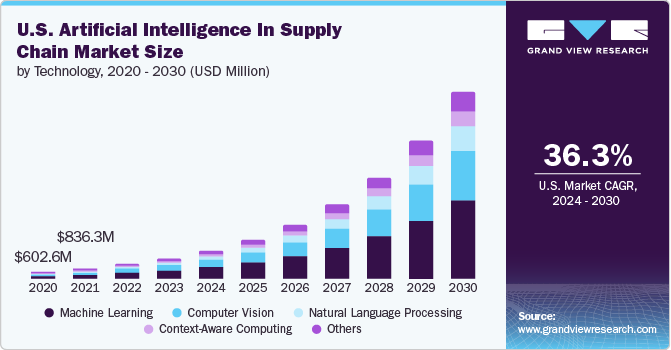
Definition
As we see in this graph, in 2025, Artificial Intelligence (AI) is revolutionizing global supply chain management by providing more accurate forecasting, optimized routing. AI-driven supply chain intelligence enables businesses to predict demand patterns, adjust production schedules, and improve logistics in a way that was previously not possible. By leveraging big data, machine learning, and predictive analytics, companies can enhance decision-making processes, reduce inefficiencies, and gain a competitive edge.
Here are two examples of AI applications in supply chain management:
AI-Powered Demand Forecasting: AI tools analyze historical sales data, market trends, and other external factors to predict future demand more accurately, allowing businesses to adjust inventory levels, production schedules, and supply chain processes accordingly, like Locus AI .
AI-Driven Route Optimization: AI systems use real-time data, including traffic patterns and weather forecasts, to dynamically optimize delivery routes, reducing fuel consumption and improving delivery efficiency by minimizing delays like IBM Watson Supply Chain.
Current Statistics
- 65% of supply chain professionals in 2025 are using AI-powered tools for demand forecasting and inventory management, a substantial increase from 45% since 2023.
- In the U.S., for example, the artificial supply chain market is projected to grow by 36.3% between 2024 and 2030, highlighting the rapid integration of advanced technologies in logistics
- 55% of businesses have reported that AI has helped them improve supply chain visibility, allowing for better coordination and faster response to market changes.
Customer Impact
As supply chains become more intelligent through AI, customers are seeing faster, more reliable deliveries with better tracking and real-time updates. AI-driven insights allow businesses to manage inventory more effectively, reducing the likelihood of stockouts or delays. This leads to a more seamless and consistent customer experience, which is becoming increasingly important as consumers demand faster and more transparent delivery options. Moreover, AI helps companies respond quickly to changing market conditions, so customers are less likely to encounter disruptions or long delays in their orders, leading to higher satisfaction and loyalty.
Industry Examples
AI is increasingly embedded in various sectors, and the logistics and shipping industry is no exception. From route optimization to predictive analytics, it plays a central role in shaping freight shipping trends, enabling faster deliveries, reducing costs, and improving supply chain visibility across global networks.
- UPS: UPS uses AI through its ORION system, which optimizes delivery routes for drivers. This system analyzes real-time delivery data and traffic conditions to determine the fastest and most fuel-efficient routes. ORION has helped UPS significantly reduce fuel costs
- DHL: They have developed a platform called Resilience360, which uses artificial intelligence and machine learning to monitor and analyze risks throughout the supply chain. It allows DHL to predict potential disruptions, such as strikes or natural disasters, and respond quickly to minimize their impact.
Actionable Advice
To fully harness the potential of AI in shipping, businesses can follow several key strategies. Here is some advice to better utilize AI in your shipping operations:
- Implement AI-Powered Demand Forecasting: Invest in AI tools that analyze historical data and market trends to predict demand more accurately. AI systems help ensure that inventory levels are optimized, reducing the risk of stockouts or excess inventory. AI can also improve order planning, leading to more efficient procurement and production processes.
- Adopt AI-Driven Inventory Optimization: Utilize AI to improve inventory management by predicting the optimal stock levels based on real-time data. AI systems can adjust inventory levels dynamically based on customer orders, seasonal trends, and market shifts. This leads to reduced waste, better cash flow, and improved customer satisfaction through timely deliveries.
- Leverage AI for Route Optimization and Logistics: They can analyze traffic patterns, weather data, and delivery windows to reduce fuel consumption, improve delivery times, and increase overall logistics efficiency. For businesses with a global supply chain, AI can help coordinate international shipments by predicting the best times to ship based on external factors such as geopolitical events or economic changes.
Siam Shipping Info
SIAM Shipping info: Choosing the right freight forwarding software is essential for businesses looking to improve efficiency, reduce costs, and gain full control over their supply chain. At Siam Shipping, we help you identify and implement the digital solutions best suited to your freight needs. Contact Siam Shipping today for more information.
Trend 5: Freight Shipping Will Become More Convenient and Data-Driven
Definition
In 2025, advancements in technology are making freight shipping more convenient and data-driven. With the increasing availability of real-time data and sophisticated transportation management systems (TMS), businesses can now make better-informed decisions and streamline their supply chain operations. The use of data-driven insights allows companies to track shipments, predict delays, optimize routes, and monitor performance in real-time, ensuring faster and more efficient delivery processes.

Here are some of the most widely used TMS:
- SAP Transportation Management: is an integrated solution that optimizes the entire transportation process, from route planning to freight auditing and payment, offering real-time visibility and advanced analytics to improve efficiency and reduce transportation costs.
- Oracle Transportation Management: Oracle’s TMS leverages AI and machine learning to optimize route planning, carrier selection, and freight payment, providing end-to-end visibility, cost control, and performance analytics for improved supply chain management.
Current Statistics
As we move forward, businesses are leveraging real-time data more than ever to stay competitive in the evolving freight shipping landscape. This technological shift is reshaping how companies manage their logistics.
- 78% of logistics companies in 2025 are now using real-time data for supply chain optimization, an increase from 63% in 2024.
- The global market for TMS is projected to grow by 15% annually through 2025, highlighting the increasing adoption of these technologies.
- 69% of consumers expect real-time shipment tracking updates as part of the standard service in 2025.
Customer Impact
In 2025, customers increasingly expect transparency and real-time updates on their shipments. With 72% of B2B buyers seeking detailed insights into the environmental impact of shipments, businesses must offer unparalleled visibility. Real-time data not only improves operational efficiency but also enhances customer satisfaction by reducing uncertainties and building trust. As customer expectations continue to evolve, companies face mounting pressure to meet the demand for transparency, efficiency, and security. This shift is driven by the rise of data-driven logistics solutions powered by TMS, helping to prevent shipping scams and ensure reliable service.
Industry Examples
As the logistics industry continues to integrate advanced data systems, these companies are setting the standard for how freight shipping can become more convenient and efficient. Their examples illustrate how businesses can leverage technology to stay ahead. Notable companies are already adopting data-driven freight shipping solutions to enhance customer satisfaction and optimize their operations. Here are a few key examples:
- FedEx: FedEx utilizes data-driven insights to streamline last-mile delivery, ensuring more accurate delivery windows and reducing delays.
- Maersk: The global shipping giant, Maersk, is using data analytics to track global supply chains, predict delays, and make proactive decisions to improve delivery times.
Actionable Advice
To fully leverage the benefits of data-driven shipping, businesses must adopt a series of practical strategies. These steps can significantly improve operational efficiency while meeting customer demands for better service.
- Implement TMS that offer real-time tracking and predictive analytics to enhance decision-making and improve visibility.
- Integrate automated tools that provide dynamic route optimization, helping reduce delays and fuel costs while increasing overall delivery speed.
- Prioritize transparency by offering customers access to real-time shipment tracking, ensuring that your service aligns with their expectations.
Siam Shipping Tip
DocShipper Advice : If you don’t have access to advanced logistics facilities, even though they are crucial for optimizing your supply chain efficiency, you may not be able to fully capitalize on their potential. Explore our logistics facilities services designed to streamline your shipping operations. We provide comprehensive logistics, warehousing, and distribution solutions globally. Contact our experts today, and we’ll be happy to assist you in optimizing your supply chain.
Trend 6: Nearshoring and Supply Chain Diversification
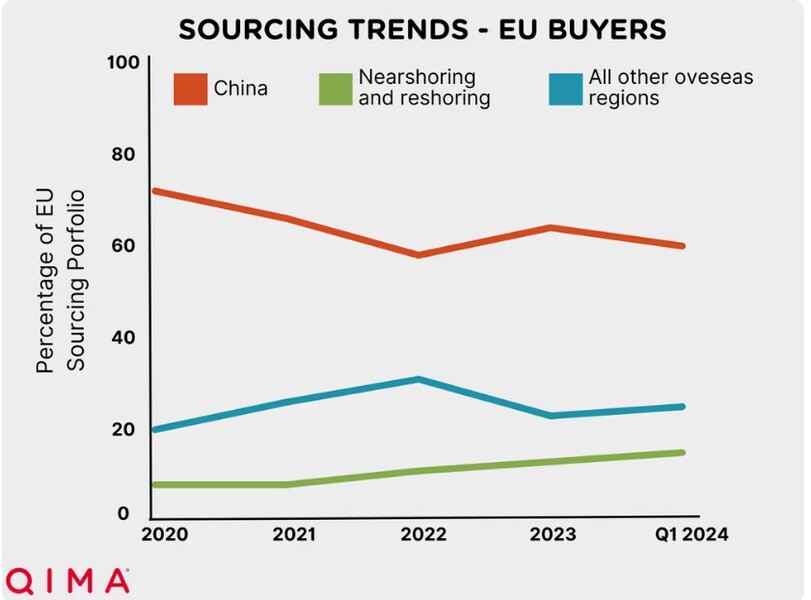
Trend
Nearshoring and supply chain diversification have become key strategies for businesses seeking to reduce dependence on global supply chains and minimize risks. The COVID-19 pandemic, geopolitical tensions, and supply chain disruptions have highlighted the vulnerabilities of logistics chains. In response, companies are opting for more localized sourcing solutions with suppliers closer to end markets, reducing delivery times. Turning to local suppliers, companies improve resilience and create more efficient and flexible options for e-commerce in the process.
Current Statistics
These statistics provide insight into how this freight shipping trend is evolving and its increasing importance in the global market.
- In 2024, 68% of companies are looking to diversify their sources of supply to reduce risks from global logistic disruptions.
- The chart shows, for example, that European sourcing from China decreased from 70% to 60% in 2024, while nearshoring and restoring steadily increased from 10% to 15% over the same period.
- By 2025, nearly 50% of companies plan to reshore at least part of their production due to global economic uncertainties.
Customer Impact
By 2025, customers expect businesses to deliver quickly and reliably, with less reliance on global supply chains prone to disruptions. Supply chain diversification and nearshoring meet these expectations by offering shorter delivery times and greater reliability. Consumers are increasingly aware of global risks and prioritize companies that can ensure supply continuity, even during crises. Therefore, companies adopting these new practices will have a competitive edge in terms of customer satisfaction and loyalty.
Industry Examples
Many businesses are turning to diversification and reshoring to minimize the risk of logistical disruptions. For example, some automotive companies have started reshoring spare parts production to Europe to protect against global trade tensions. Additionally, fashion brands are now sourcing raw materials from local suppliers to reduce carbon footprints and delivery times while meeting growing consumer demand for sustainable and ethical products.
- Apple is increasingly nearshoring its manufacturing by expanding operations in countries like India and Vietnam, reducing its reliance on China. To mitigate geopolitical risks, reduce supply chain disruptions, and adapt to shifting trade policies.
- Nike is diversifying its supply chain by increasing production capacities in countries like Vietnam, Indonesia, and Mexico, moving away from overconcentration in China.They want to reduce geopolitical risks, improve supply chain resilience, and meet growing demand more flexibly in North America and Europe.
Actionable Advice
These strategies will help businesses navigate an increasingly uncertain environment. By implementing these steps, you can not only minimize risks but also meet rising customer expectations for reliability and sustainability.
- Identify and establish partnerships with local suppliers to minimize procurement delays and strengthen your supply chain resilience. By sourcing goods locally, companies can reduce lead times, cut down on shipping costs, and improve overall responsiveness.
- Diversify your sources of supply based on geopolitical risks, transportation costs, and local market stability.To safeguard against geopolitical instability, fluctuating transportation costs, and potential supply chain disruptions, businesses should avoid over-relying on a single source or region for key products.
- Invest in localized manufacturing solutions for mass-market products to reduce risks and improve delivery flexibility. This investment allows companies to respond faster to consumer demand, adjust production schedules quickly, and minimize inventory holding costs.
Trend 7: Digital Freight Marketplaces
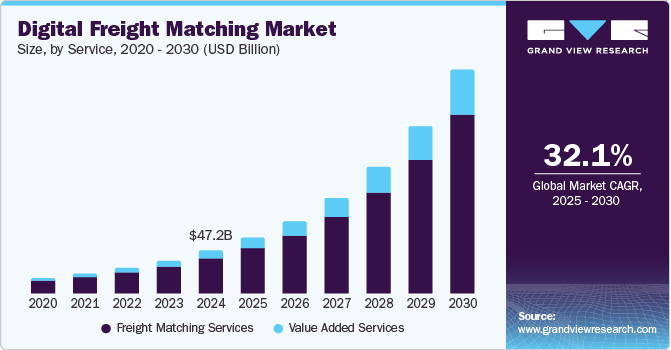
Definition
Digital freight marketplaces are online platforms that connect shippers with carriers, optimizing the freight booking process by providing real-time pricing, capacity availability, and a transparent view of the transportation market. These platforms streamline the process of matching supply and demand, often using AI to improve routing, reduce delays, and ensure cost-effective shipping solutions.
- Loadsmart: is a leading digital freight platform that uses AI and machine learning to provide automated freight booking, real-time tracking, and optimized routing for shippers and carriers. By streamlining operations and reducing inefficiencies, Loadsmart enhances transparency and helps businesses save on shipping costs.
- Transfix: connects shippers with carriers through its digital freight marketplace, offering end-to-end visibility, dynamic pricing, and automated load matching. With real-time insights and predictive analytics, it helps companies improve freight management, optimize routes, and increase supply chain efficiency.
Current Statistics
We will explore in the next section the statistics that demonstrate how this shift in the market is impacting customer expectations and why businesses must adapt to stay competitive.
- The global digital freight brokerage market is expected to grow at a compound annual growth rate (CAGR) of 18% from 2024 to 2028.
- More than 40% of logistics companies are investing in digital freight solutions to enhance their shipping efficiency and reduce operational costs.
- On the graph, the digital freight market is expected to experience significant growth of 32.1% between 2025 and 2030.
Customer Impact
Consumers are increasingly demanding lower shipping costs and faster delivery times, putting pressure on businesses to optimize their logistics processes. Digital freight platforms enable businesses to provide customers with more competitive pricing, faster shipment processing, and reliable delivery. With the availability of real-time data, businesses can offer customers more accurate delivery estimates and improve transparency throughout this freight shipping trend.
Industry Examples
The next section will provide actionable steps that businesses can take to harness the power of these platforms and improve their freight operations. Here are some companies currently leveraging digital freight marketplaces to improve their operations:
- Target: Using Loadsmart, Target has optimized its shipping process with real-time tracking and better cost forecasting. This helps them meet customer demands for faster and more cost-efficient deliveries.
- PepsiCo: PepsiCo utilizes Transfix for end-to-end freight visibility, allowing them to adjust routes dynamically and reduce operational inefficiencies, ensuring that their goods are delivered faster and at a lower cost.
- Maersk: The global shipping giant has adopted digital solutions through its own platform, enabling customers to book and manage freight seamlessly. With real-time information about capacity, price, and status, Maersk has improved the booking process and customer satisfaction.
Actionable Advice
By incorporating the strategies below, you will optimize your business logistics, cut costs, and stay competitive in an increasingly digital freight marketplace.
- Leverage Digital Platforms: Investigate and adopt digital freight marketplaces that align with your supply chain needs. These platforms provide access to a wider pool of carriers and better pricing transparency.
- Integrate Technology for Efficiency: Implement AI-driven systems that can dynamically match demand with capacity, ensuring better resource utilization and reduced delivery delays.
- Improve Data Management: Collect and use data from these platforms to forecast demand, optimize shipping routes, and reduce idle time for drivers and vehicles.
Siam Shipping Tip
SIAM Shipping Tip: To truly optimize your digital marketplace, selecting the right freight forwarding software is crucial . Streamline your logistics with software that provides real-time pricing, routing, and AI-driven optimization. At Siam Shipping, we’re dedicated to helping you enhance your operations and maximize efficiency.
Reach out to us today to learn how we can help elevate your logistics game.
Summary of the 7 Key Trends
This summary highlights the seven major trends shaping the future of shipping, offering a clear insight into how the industry is evolving. From the rise of digital freight marketplaces leveraging AI to streamline shipping processes to the increasing importance of nearshoring and supply chain diversification as companies shift away from global supply chains, these trends redefine how goods are moved worldwide.
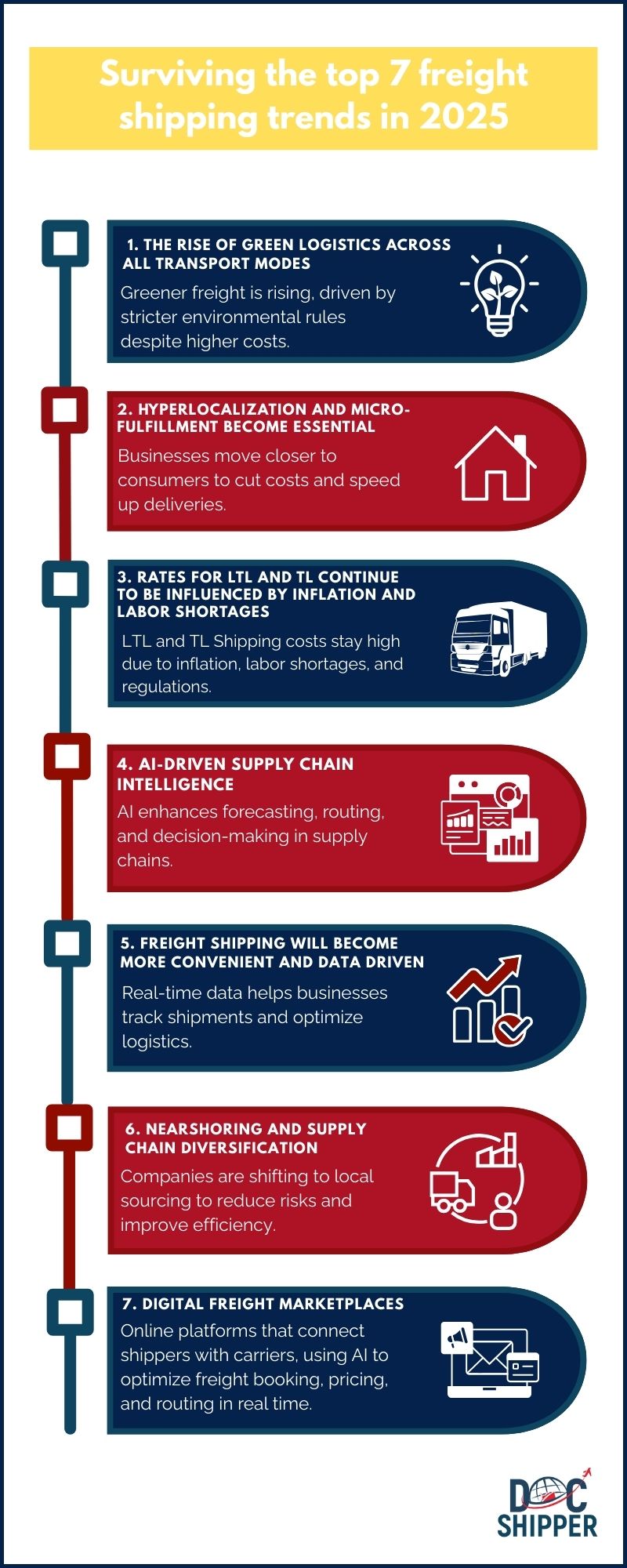
Conclusion
These evolving shipping trends highlight a growing customer demand for transparency, real-time updates, and security in freight shipping. Businesses must leverage data-driven solutions like TMS to meet these expectations, improve operational efficiency, and safeguard against freight scams.
For 2025 and beyond, don’t hesitate to contact us— we offer a range of services like cold storage or packing services, for examples, to help you stay ahead and meet your customers’ evolving needs.
FAQ | Surviving the top 7 freight shipping trends for 2025
Read more
Looking for more? These articles might interest you:
DocShipper info: Do you like our article today? For your business interest, you may like the following useful articles :
Need Help with Logistics or Sourcing ?
First, we secure the right products from the right suppliers at the right price by managing the sourcing process from start to finish. Then, we simplify your shipping experience - from pickup to final delivery - ensuring any product, anywhere, is delivered at highly competitive prices.

Fill the Form
Prefer email? Send us your inquiry, and we’ll get back to you as soon as possible.
Contact Us





